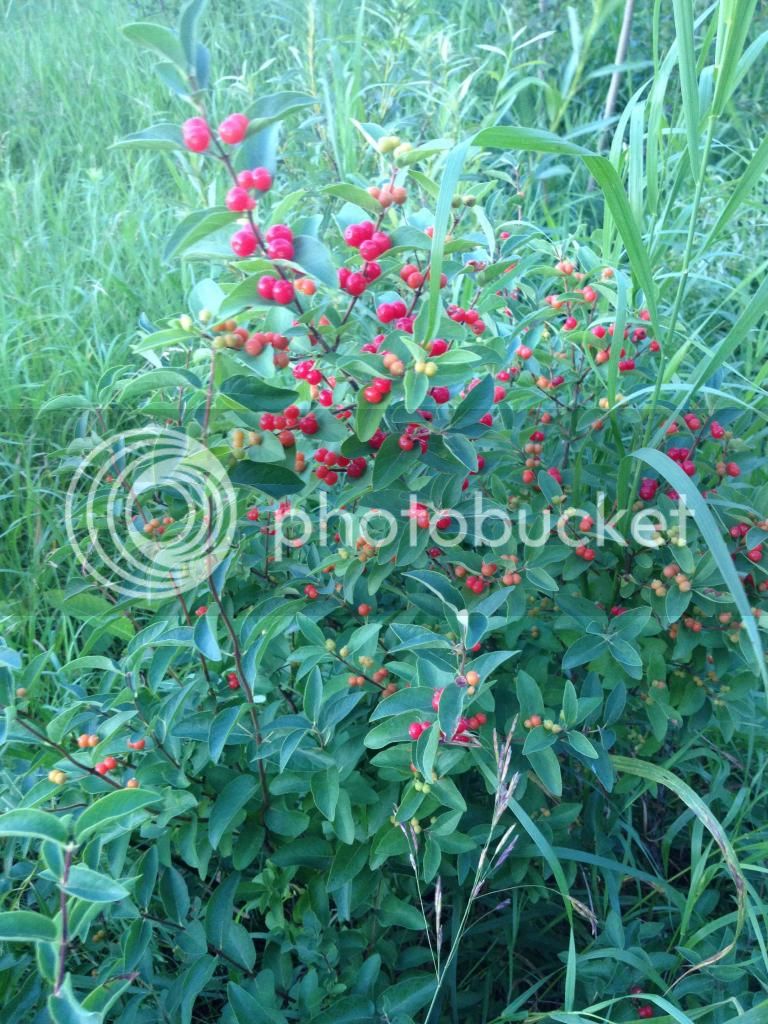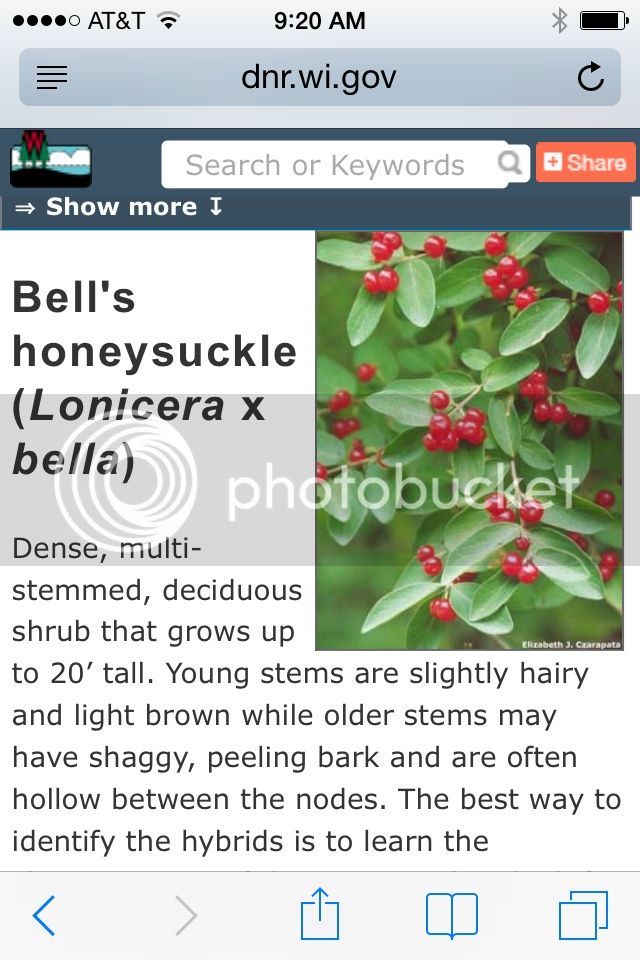You are using an out of date browser. It may not display this or other websites correctly.
You should upgrade or use an alternative browser.
You should upgrade or use an alternative browser.
Plant ID
- Thread starter Riggsgwp->
- Start date
Tree Spud
5 year old buck +
My guess would be honey suckle, possibly Lonicera tartarica
http://www.dnr.state.mn.us/invasives/terrestrialplants/woody/exotichoneysuckles.html
http://www.dnr.state.mn.us/invasives/terrestrialplants/woody/exotichoneysuckles.html
SD51555
5 year old buck +
My guess would be honey suckle, possibly Lonicera tartarica
http://www.dnr.state.mn.us/invasives/terrestrialplants/woody/exotichoneysuckles.html
I think ya nailed it. Looks like a perfect match. I'd whack it.
Riggsgwp->
5 year old buck +
It's the only one I've seen on my place so I think I will spray it cause I don't need another issue to go along with my thistle headache. Thanks guys!
Riggsgwp->
5 year old buck +
Riggsgwp->
5 year old buck +
Thanks Stu. It is a pretty plant and it is located by my campsite which is not an area I'm real concerned with for now. I think I will monitor it for awhile.
I have quite a number of these shrubs on my land in SE MN and they do seem to take over an area. But they do create thick cover in the process which is frequently used as bedding areas.
I don't really want to completely eliminate it because it does create nice cover, but I am trying to kill the honeysuckle that is growing close to native shrubs like plums, hazel and dogwoods. Hopefully in time I'll be able to get the native shrubs to expand into areas currently filled with honeysuckle and buckthorn. But the cover created by the invasives does have benefits in my opinion.
I don't really want to completely eliminate it because it does create nice cover, but I am trying to kill the honeysuckle that is growing close to native shrubs like plums, hazel and dogwoods. Hopefully in time I'll be able to get the native shrubs to expand into areas currently filled with honeysuckle and buckthorn. But the cover created by the invasives does have benefits in my opinion.
sandbur
5 year old buck +
I look at some of the nearby wildlife areas and it appears that they are being managed for oak savanna. I just m not sure about the benefits to the wildlife that presently exists here.
Stu-your area might have been part of the oak savannah that went to the big woods about 400-500 years ago. Perhaps as a result of the Indians not burning the area, or the Indians getting horses and chasing buffalo on the plains, or as a result of the shuffling of tribes as the white man approached our area.
Maybe climate change, but I'll bet on less burning by the natives.
My area was probably pretty much prairie/savannah.
Stu-your area might have been part of the oak savannah that went to the big woods about 400-500 years ago. Perhaps as a result of the Indians not burning the area, or the Indians getting horses and chasing buffalo on the plains, or as a result of the shuffling of tribes as the white man approached our area.
Maybe climate change, but I'll bet on less burning by the natives.
My area was probably pretty much prairie/savannah.
Riggsgwp->
5 year old buck +
I like that take on invasives filling a niche Stu. On my property I want the habitat to serve my purposes and that's what I'm working towards. The FSA/NRCS tried to dictate what trees I planted but I fought them and that's why most of my tree plantings consist of shrub varieties and the occasional red cedar;)
kskid
5 year old buck +
I don't really want to completely eliminate it because it does create nice cover, but I am trying to kill the honeysuckle that is growing close to native shrubs like plums, hazel and dogwoods.
Right now (may change) my take on bush honeysuckle and buckthorn is to use them to my advantage for deer and to attempt to prevent them spreading to new areas.
Guys, I really do get what you're saying. But please consider that often what we want just isn't compatible with reality. An alcoholic may just want to have a glass of wine with dinner or drink a toast at his daughter's wedding. He might even pull it off for awhile. But reality will eventually become apparent, usually with the realization that control has been lost.
I'm not advocating on ecological grounds - we'll probably never be able to put the genie back in the bottle. I'm advocating from the position of, "Why would you let this happen to your piece of heaven?" I don't mean to tell anyone what to do - I respect your opinions and how you want to run your places. I just don't understand how someone could put so much care and work to improve a place and then risk it all by letting this stuff get a foothold. I strongly speak out against the invasive honeysuckles (primarily lonicera maackii) so that you can make your own informed decision. IMO the benefits cited are insignificant when weighed against the (probable) potential for disaster. And the benefits cited can be achieved with alternative plants that are of greater wildlife value in every way. Why risk it?
It makes me sick when I look at pictures and treestand video of what my place looked like when I bought it and think about how much easier it would have been to control the honeysuckle then. I had no idea what it would become. I apologize for yet another "rant against the plant". I just believe in the message.
sandbur
5 year old buck +
Guys, I really do get what you're saying. But please consider that often what we want just isn't compatible with reality. An alcoholic may just want to have a glass of wine with dinner or drink a toast at his daughter's wedding. He might even pull it off for awhile. But reality will eventually become apparent, usually with the realization that control has been lost.
I'm not advocating on ecological grounds - we'll probably never be able to put the genie back in the bottle. I'm advocating from the position of, "Why would you let this happen to your piece of heaven?" I don't mean to tell anyone what to do - I respect your opinions and how you want to run your places. I just don't understand how someone could put so much care and work to improve a place and then risk it all by letting this stuff get a foothold. I strongly speak out against the invasive honeysuckles (primarily lonicera maackii) so that you can make your own informed decision. IMO the benefits cited are insignificant when weighed against the (probable) potential for disaster. And the benefits cited can be achieved with alternative plants that are of greater wildlife value in every way. Why risk it?
It makes me sick when I look at pictures and treestand video of what my place looked like when I bought it and think about how much easier it would have been to control the honeysuckle then. I had no idea what it would become. I apologize for yet another "rant against the plant". I just believe in the message.
I could substitute buckthorn for honeysuckle and say the same thing about my property. Yet the buckthorn provides cover and I realize I will never live long enough or have time to do the things I like to do if I wage war on the buckthorn. Plus there is the buckthorn on the adjacent properties.
sandbur
5 year old buck +
"Wildlife" value means so many different things to different people. To hunters, it generally means is an area good for deer, pheasants, grouse, turkey, etc. To a DNR employee it may mean is it good for some endangered songbird, butterfly, beetle, etc. Neither is right or wrong...but I do believe that when hunters pay for the management of these lands, hunters should benefit.
I would add that when hunters and sportsmans clubs buy the land and donate it to the DNR, they should also benefit.
SD51555
5 year old buck +
kskid...I certainly respect your passion and opinion on the subject of bush honeysuckle. Not that many years ago I would have been saying the exact same things. I have seen first hand what it can do over a span of time. There was no bush honeysuckle on my old place when I was a kid, but by the time I was in my mid 20's it had begun the takeover. By the time I sold in my mid 40's it had formed a monoculture in a few spots. So had the buckthorn...
I fought them both for many years by hand and with chemicals. The neighbors did not...I lost.
Here on my new place I have areas of monoculture of ironwood and prickly ash, I'd take honeysuckle over the ironwood but not the prickly ash. When I create new forest openings the first thing that moves in is prickly ash. I've found zero new, young bush honeysuckles popping up, of course that doesn't mean things won't change as time goes on. If they do, I'll go back to waging war on the stuff.
That's interesting. On my dad's place in McLeod county, I've tried to protect ironwood. There, our woods is dominated by huge basswoods and box elder. We would seek out ironwood that had fallen or gotten knocked over for firewood. That stuff is hard as all get out. It's hard on a chainsaw and a pain to split, but it burns hotter and longer than (dare I say it) oak. Could you offer it up for DIY'ers to come and harvest it for firewood? The basswood grow 6-10ft a year and are shading out our white and bur oaks. Where I can, I try to keep the canopy open so those others can reach for some sun. I love basswood when it's resprouting, but after a couple years, I go back and cut it all down again to keep the regrowth within reach. And that really keeps the ground cover thick.
I think a lot of our shift to monocultures is a result of a lack of disturbance in the forest. Back in the days of forest fires, logging, and sheering there was always a reset that allowed stuff to get going again. I know it's not practical, but I wonder how honeysuckle and prickly ash would take to a controlled burn?
SD51555
5 year old buck +
I could open it up for DIY'ers....but I won't ;)
I have one guy and his brother who I'd trust to not sue me for cutting their legs off here, but that's about it. They're coming out tomorrow to take down some dead ash and elm in a spot where I want them removed. They won't be allowed to wander all over taking out ironwood though. The ironwood's going to get hinged or dropped and left to rot.
Pretty sure the reason the ironwood is thick here is due to the land having cattle on it for years before I bought it (no more). Ironwood is obviously not a preferred food for cattle (or deer).
I completely understand that. I remember making iron wood when I was younger and I could never understand why we'd waste so much time cutting through such small logs that took so long. And that was when I learned about density and heat differences in firewood. Do you mushroom hunt your elms? If they're safe to cut down yet, they are probably prime for morels.
Similar threads
- Replies
- 26
- Views
- 964
- Replies
- 6
- Views
- 590



